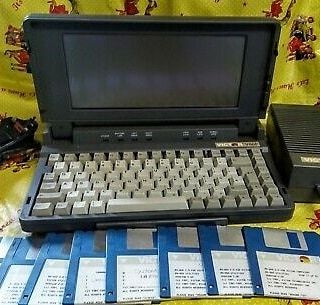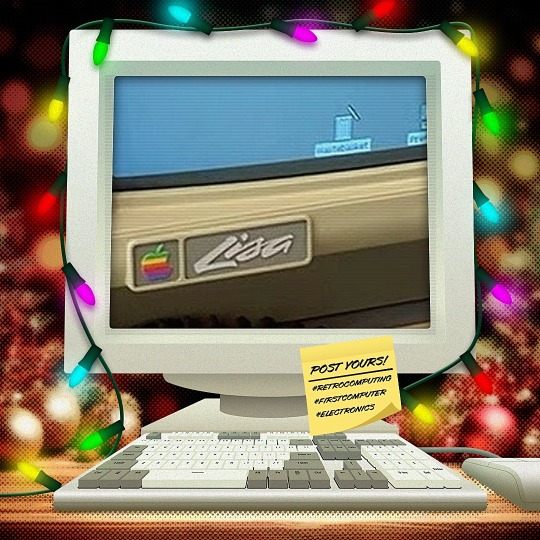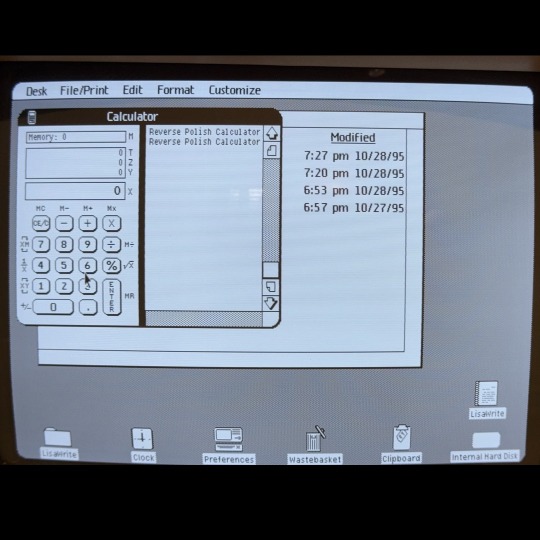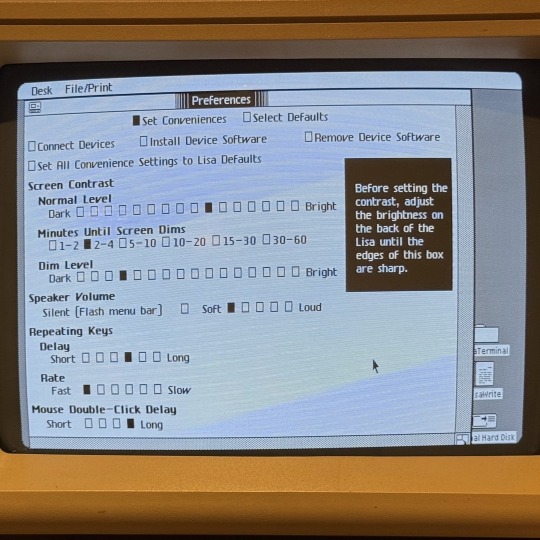#1980scomputing
Explore tagged Tumblr posts
Text





🎄💾🗓️ Day 5: Retrocomputing Advent Calendar - Compaq DeskPro 1 🎄💾🗓️
The Compaq Deskpro Model 1, introduced in 1984, featured an 8 MHz Intel 8086 CPU, which had better performance than the IBM PC's 4.77 MHz 8088 processor. It combined Color Graphics Adapter (CGA) graphics with high-resolution Monochrome Display Adapter (MDA) text, delivering enhanced text display. This improved speed and better text clarity over IBM PCs equipped with standard graphics. The Deskpro's architecture allowed for various disk configurations and was an influence for many personal computers.
Check out The Centre for Computing History's Compaq DeskPro 1 page (and other resources there!)
And here's a somewhat "first computer" story from Adafruit team member Anne!
"In my first year of EE (junior) we were limited to larger computers. My senior year we could check out Compaq Portables (really luggables) which allowed us to run C compilers and compile cross assemblers onto a machine for ease of use.
When I graduated, I needed a computer and went to a PC store. They contrasted the IBM PC/XT 8088 with the newly released Compaq DeskPro 1. With an 8086 processor running at 7.16 MHz, it was faster. It came with monochrome graphics (green or yellow) with both CGA and text mode video. I bought the dual 5.25" floppy version to start, to have enough money for an IBM ProPrinter for output.
The machine was great and I spent many hours on programming, databases, word processing and more. It was upgraded eventually to a 30MB RLL hard disk and an added 720k 3.5" floppy."
It got through the '286 era and was supplanted by a '386 machine. I still have the DeskPro and I intend to resurrect it in the not too distant future.
Have first computer memories? Post’em up in the comments, or post yours on socialz’ and tag them #firstcomputer #retrocomputing – See you back here tomorrow!
#compaqdeskpro#retrocomputers#computinghistory#vintagepc#1980scomputing#intel8086#pcarchitecture#desktophistory#cgagraphics#oldcomputers#classictech#8086cpu#programminghistory#vintagetech#earlypcs#pcbuilding#nostalgiatech#technostalgia#pcstory#retroadvent
25 notes
·
View notes
Video
youtube
The Hobbit walkthrough part one adventure
#hobbit#the hobbit#hobit adventure game#zx spectrum#zxspectrum#melbournehouse#1980scomputing#tolkien
0 notes
Photo

https://rover.ebay.com/rover/0/0/0?mpre=https%3A%2F%2Fwww.ebay.co.uk%2Fulk%2Fitm%2F254230214320 Opening bid £28.50 Buy it now £54.50 #vintage #vintagecomputer #1980s #victorV86 #1980scomputer #retro #computerscience #oldtech UNTESTED 1980s 1989 Victor V86P Vintage Personal Computer Laptop PC retro tech PLEASE NOTE THIS IS UNTESTED so I don't know if it works Vintage 1989 Victor V86P Power pack Cable Disks Please see photos for condition. There is a crack on the back and something missing off the corner (see close up photos) Combined weight before packaging 4kg which is why the shipping may seem high (at Bognor Regis) https://www.instagram.com/p/BxerXt_nFif/?utm_source=ig_tumblr_share&igshid=e22pib5pbesj
0 notes
Photo

He's in for a rude awakening! Doesn't he know Internet porn was much more expensive in the 80s? Hope he's packed his check book 🙄 #digitalart #copart #copartist #craponpurposeart #slackerart #lazyart #1980s #1980scomputers https://www.instagram.com/p/BwNCwktF0lw/?utm_source=ig_tumblr_share&igshid=13v501uqy2rd6
0 notes
Photo

UNIX: Making Computers Easier To Use -- AT&T Archives film from 1982, Bell Laboratories For more from the AT&T Archives, visit... #surnativa #1970scomputers #1980scomputers #1982 #atamptbusinessoperation #atamptarchives #belllabsorganization #dennisritchieauthor #earlycomputers #history #kenthompson #unixsoftware Source: https://surnativa.com/unix-making-computers-easier-to-use-att-archives-film-from-1982-bell-laboratories/?feed_id=23440&_unique_id=5f4cae0f835c7
0 notes
Photo

Atari ST - 1980s Reliable and Sophisticated Music Production http://ehelpdesk.tk/wp-content/uploads/2020/02/logo-header.png [ad_1] The Atari ST was the first compu... #1908scomputer #1980scomputing #abletonlive #ataricubase #atarist #bluesguitar #cubaseversion2 #danbaker #danbakermusician #dj #drums #electronicmusic #fingerstyleguitar #flstudio #fostexd-160 #fostexd160 #garageband #guitar #harmonica #keyboardinstrument #logicprox #midi #miditimecode #music #musiccomposition #musicmixing #musicproduction #musictheory #musician #piano #rolandsc-880 #singing #songwriting #st1040
0 notes
Text










🎄💾🗓️ Day 9: Retrocomputing Advent Calendar - The Apple Lisa 🎄💾🗓️
The Apple Lisa, introduced on January 19, 1983, was a pioneering personal computer notable for its graphical user interface (GUI) and mouse input, a big departure from text-based command-line interfaces. Featured a Motorola 68000 CPU running at 5 MHz, 1 MB of RAM (expandable to 2 MB), and a 12-inch monochrome display with a resolution of 720×364 pixels. The system initially included dual 5.25-inch "Twiggy" floppy drives, later replaced by a single 3.5-inch Sony floppy drive in the Lisa 2 model. An optional 5 or 10 MB external ProFile hard drive provided more storage.
The Lisa's price of $9,995 (equivalent to approximately $30,600 in 2023) and performance issues held back its commercial success; sales were estimated at about 10,000 units.
It introduced advanced concepts such as memory protection and a document-oriented workflow, which influenced future Apple products and personal computing.
The Lisa's legacy had a huge impact on Apple computers, specifically the Macintosh line, which adopted and refined many of its features. While the Lisa was not exactly a commercial success, its contributions to the evolution of user-friendly computing interfaces are widely recognized in computing history.
These screen pictures come from Adafruit fan Philip " It still boots up from the Twiggy hard drive and runs. It also has a complete Pascal Development System." …"mine is a Lisa 2 with the 3.5” floppy and the 5 MB hard disk. In addition all of the unsold Lisa machines reached an ignominious end."
What end was that? From the Verge -
In September 1989, according to a news article, Apple buried about 2,700 unsold Lisa computers in Logan, Utah at a very closely guarded garbage dump. The Lisa was released in 1983, and it was Apple’s first stab at a truly modern, graphically driven computer: it had a mouse, windows, icons, menus, and other things we’ve all come to expect from “user-friendly” desktops. It had those features a full year before the release of the Macintosh.
Article, and video…
youtube
Check out the Apple Lisa page on Wikipedia
, the Computer History's article -
and the National Museum of American History – Behring center -
Have first computer memories? Post’em up in the comments, or post yours on socialz’ and tag them #firstcomputer #retrocomputing – See you back here tomorrow!
#applelisa#retrocomputing#firstcomputer#applehistory#computinghistory#vintagecomputers#macintosh#1980scomputers#applecomputer#gui#vintagehardware#personalcomputers#motorola68000#technostalgia#twiggydrive#floppydisk#graphicalinterface#applefans#computinginnovation#historictech#computerlegacy#techthrowback#techhistory#memoryprotection#profiledrive#userinterface#firstmac#computermilestone#techmemories#1983tech
113 notes
·
View notes
Text






🎄💾🗓️ Day 16: Retrocomputing Advent Calendar - Tandy 1000🎄💾🗓️
Tandy's 1000, sold by Tandy Corporation in 1984 via its RadioShack stores, was a low-cost home computer designed to be compatible with IBM PC software. It shipped with an Intel 8088 processor, 128 KB of RAM, expandable to 640 KB, and had better-at-the-time graphics and sound than many of the standard PCs. The 1000 had the Tandy Graphics Adapter, or TGA, and the more superior SN76496 or NCR 8496 sound chips. The built-in joystick port also made it desirable for gamers and home users. Different models were produced, each with improved hardware, before being discontinued in 1993. One of the main selling features was its compatibility with IBM-PC, the MS-DOS operating system, and expansion slots for peripheral devices.
And check out our guide! Tandy 1000 Keyboard to USB with CircuitPython. https://learn.adafruit.com/tandy-1000-keyboard-to-usb-with-circuitpython
Have first computer memories? Post’em up in the comments, or post yours on socialz’ and tag them #firstcomputer #retrocomputing – See you back here tomorrow!
#retrocomputing#tandy1000#vintagecomputers#1980scomputers#ibmpccompatible#firstcomputer#tandycorporation#radioshack#int8088#msdos#pcgaming#nostalgiatech#oldschoolgaming#classictech#retrogaming#computermemories#vintagepc#pcretro#techhistory#throwbacktech#joystickport#tandygraphics#80scomputing#retrotechnology#techthrowback#earlypcs#computerhistory#retrohardware
21 notes
·
View notes